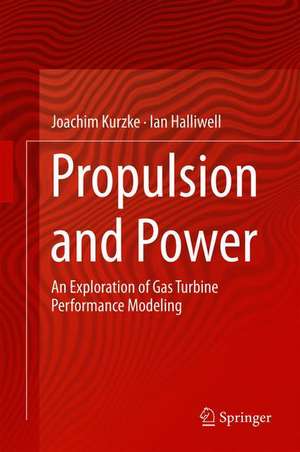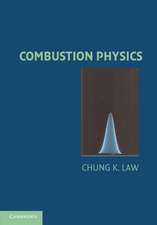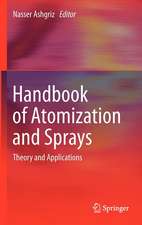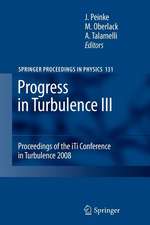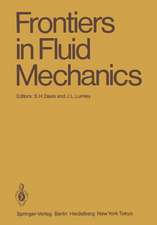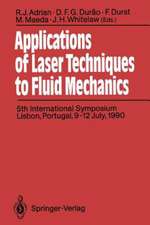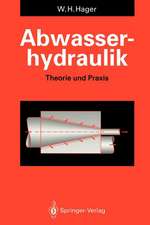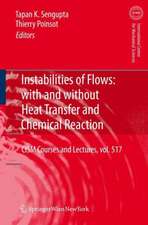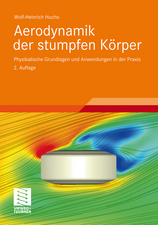Propulsion and Power: An Exploration of Gas Turbine Performance Modeling
Autor Joachim Kurzke, Ian Halliwellen Limba Engleză Hardback – 11 iun 2018
| Toate formatele și edițiile | Preț | Express |
|---|---|---|
| Paperback (1) | 1130.59 lei 6-8 săpt. | |
| Springer International Publishing – 8 ian 2019 | 1130.59 lei 6-8 săpt. | |
| Hardback (1) | 1409.34 lei 6-8 săpt. | |
| Springer International Publishing – 11 iun 2018 | 1409.34 lei 6-8 săpt. |
Preț: 1409.34 lei
Preț vechi: 1718.70 lei
-18% Nou
Puncte Express: 2114
Preț estimativ în valută:
269.71€ • 292.86$ • 226.56£
269.71€ • 292.86$ • 226.56£
Carte tipărită la comandă
Livrare economică 22 aprilie-06 mai
Preluare comenzi: 021 569.72.76
Specificații
ISBN-13: 9783319759777
ISBN-10: 3319759779
Pagini: 500
Ilustrații: XXIV, 755 p. 557 illus.
Dimensiuni: 155 x 235 x 50 mm
Greutate: 1.26 kg
Ediția:1st ed. 2018
Editura: Springer International Publishing
Colecția Springer
Locul publicării:Cham, Switzerland
ISBN-10: 3319759779
Pagini: 500
Ilustrații: XXIV, 755 p. 557 illus.
Dimensiuni: 155 x 235 x 50 mm
Greutate: 1.26 kg
Ediția:1st ed. 2018
Editura: Springer International Publishing
Colecția Springer
Locul publicării:Cham, Switzerland
Cuprins
Simulation tasks: New engine design.- Engine families.- Modeling an engine.- Engine model examples.- Model-based performance analysis.- Inlet flow distortion.- Transient performance simulation.- Preliminary design:- Compressor.- Turbines.- Mechanical design.- Off-design: Component performance.- Understanding off-design behavior.- Basics: Gas properties and standard atmosphere.- Spreadsheet calculations.- Non-dimensional performance.- Reynolds number corrections.- Efficiency of a cooled turinbe.- Secondary air system.- Mathematics.- Optimization.- Monte Carlo simulations.- Appendix.
Notă biografică
Joachim Kurzke spent his engineering life dealing with gas turbine performance, first at the Technical University of Munich, Institute for Flight Propulsion.
1976 Kurzke joined the performance department of the company which is now MTU Aero Engines and stayed there for 28 years. He worked on a multitude of different engine projects, designed the engine performance program MOPS for MTU, and applied it to the everyday problems in the performance department.
MOPS is due to the modular design very flexible and can be adapted easily to new requirements, however, it’s use requires significant training in gas turbine performance. This observation resulted in the development of the performance program GasTurb™. This software concentrates on the user interface, without neglecting any detail which is required for professional gas turbine performance work. After more than 20 years in the public domain, GasTurb™ is well known and acknowledged all over the world.
Kurzke has published numerous papers dealing with gas turbine performance, and was a member of several RTO (former AGARD) working groups, as well as the SAE E33 committee “Thrust in Flight”. He is still a member of the ASME/IGTI Aircraft Engine and Education Committees.
Ian Halliwell obtained his B.Sc. in Aeronautical Engineering and M.Sc. in Aerodynamics from Imperial College, London, followed by a Ph.D. in Experimental Gas Dynamics from the University of Southampton. His professional career began in 1975 at Rolls-Royce, Derby in Turbine Aerodynamics Research. He then crossed the Atlantic to work for Pratt and Whitney Canada in Mississauga and subsequently GE in Cincinnati, where he moved into the preliminary design of complete engine systems and spent a few years on the High Speed Civil Transport program. During that period, he also began teaching in GE after-hours education.
While continuingto model complete engine systems, his teaching activities continued after moving to the small business world, as a contractor at the NASA Glenn Research Center and expanded through involvement with AIAA and ASME/IGTI. He chaired the AIAA Air Breathing Propulsion and Gas Turbine Engine Technical Committees and is still an active member of AIAA. He is also a member of the ASME/IGTI Aircraft Engine and Education Committees. His connection to students and university faculty was enhanced during the 14 years he organized the AIAA International Engine Design Competition for undergraduate teams. He met Joachim Kurzke while presenting a tutorial on Preliminary Engine Design at ASME TurboExpo in 2001 and the seeds were sown for this book a few years later.
His current special interests are in new engine architectures, involving vaneless counter-rotation and exoskeletal architectures for compressors and turbines – both axial and radial. The past 10 years or so, back in aerodynamics, involved the development and application of new design tools.
1976 Kurzke joined the performance department of the company which is now MTU Aero Engines and stayed there for 28 years. He worked on a multitude of different engine projects, designed the engine performance program MOPS for MTU, and applied it to the everyday problems in the performance department.
MOPS is due to the modular design very flexible and can be adapted easily to new requirements, however, it’s use requires significant training in gas turbine performance. This observation resulted in the development of the performance program GasTurb™. This software concentrates on the user interface, without neglecting any detail which is required for professional gas turbine performance work. After more than 20 years in the public domain, GasTurb™ is well known and acknowledged all over the world.
Kurzke has published numerous papers dealing with gas turbine performance, and was a member of several RTO (former AGARD) working groups, as well as the SAE E33 committee “Thrust in Flight”. He is still a member of the ASME/IGTI Aircraft Engine and Education Committees.
Ian Halliwell obtained his B.Sc. in Aeronautical Engineering and M.Sc. in Aerodynamics from Imperial College, London, followed by a Ph.D. in Experimental Gas Dynamics from the University of Southampton. His professional career began in 1975 at Rolls-Royce, Derby in Turbine Aerodynamics Research. He then crossed the Atlantic to work for Pratt and Whitney Canada in Mississauga and subsequently GE in Cincinnati, where he moved into the preliminary design of complete engine systems and spent a few years on the High Speed Civil Transport program. During that period, he also began teaching in GE after-hours education.
While continuingto model complete engine systems, his teaching activities continued after moving to the small business world, as a contractor at the NASA Glenn Research Center and expanded through involvement with AIAA and ASME/IGTI. He chaired the AIAA Air Breathing Propulsion and Gas Turbine Engine Technical Committees and is still an active member of AIAA. He is also a member of the ASME/IGTI Aircraft Engine and Education Committees. His connection to students and university faculty was enhanced during the 14 years he organized the AIAA International Engine Design Competition for undergraduate teams. He met Joachim Kurzke while presenting a tutorial on Preliminary Engine Design at ASME TurboExpo in 2001 and the seeds were sown for this book a few years later.
His current special interests are in new engine architectures, involving vaneless counter-rotation and exoskeletal architectures for compressors and turbines – both axial and radial. The past 10 years or so, back in aerodynamics, involved the development and application of new design tools.
Textul de pe ultima copertă
The book is written for engineers and students who wish to address the preliminary design of gas turbine engines, as well as the associated performance calculations, in a practical manner. A basic knowledge of thermodynamics and turbomachinery is a prerequisite for understanding the concepts and ideas described. The book is also intended for teachers as a source of information for lecture materials and exercises for their students. It is extensively illustrated with examples and data from real engine cycles, all of which can be reproduced with GasTurb (TM). It discusses the practical application of thermodynamic, aerodynamic and mechanical principles. The authors describe the theoretical background of the simulation elements and the relevant correlations through which they are applied, however they refrain from detailed scientific derivations.
Caracteristici
Guide for solving real world problems with modern computer software Good text for teaching gas turbine design and performance Solutions of overall system simulation problems
